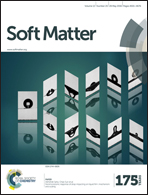Triggering bilayer to inverted-hexagonal nanostructure formation by thiol–ene click chemistry on cationic lipids: consequences on gene transfection†
Abstract
The ramification of cationic amphiphiles on their unsaturated lipid chains is readily achieved by using the thiol–ene click reaction triggering the formation of an inverted hexagonal phase (HII). The new ramified cationic lipids exhibit different bio-activities (transfection, toxicity) including higher transfection efficacies on 16HBE 14o-cell lines.


 Please wait while we load your content...
Please wait while we load your content...